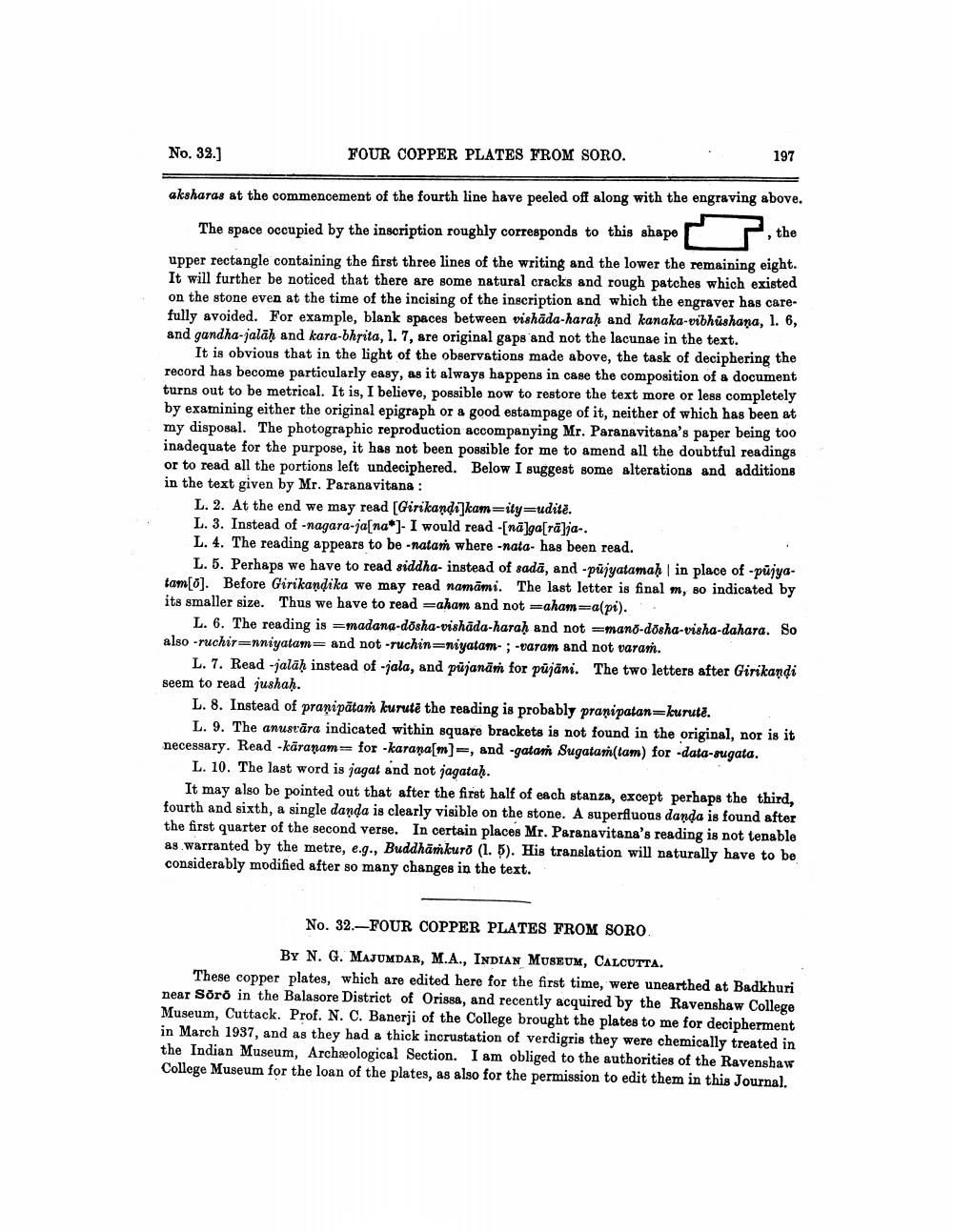________________
No. 32.]
FOUR COPPER PLATES FROM SORO.
197
aksharas at the commencement of the fourth line have peeled off along with the engraving above.
, the
The space occupied by the inscription roughly corresponds to this shape upper rectangle containing the first three lines of the writing and the lower the remaining eight. It will further be noticed that there are some natural cracks and rough patches which existed on the stone even at the time of the incising of the inscription and which the engraver has carefully avoided. For example, blank spaces between vishäda-harah and kanaka-vibhushana, 1. 6, and gandha-jalāh and kara-bhrita, 1.7, are original gaps and not the lacunae in the text.
It is obvious that in the light of the observations made above, the task of deciphering the record has become particularly easy, as it always happens in case the composition of a document turns out to be metrical. It is, I believe, possible now to restore the text more or less completely by examining either the original epigraph or a good estampage of it, neither of which has been at my disposal. The photographic reproduction accompanying Mr. Paranavitana's paper being too inadequate for the purpose, it has not been possible for me to amend all the doubtful readings or to read all the portions left undeciphered. Below I suggest some alterations and additions in the text given by Mr. Paranavitana :
L. 2. At the end we may read [Girikandi]kam=ity=udite. L. 3. Instead of -nagara-ja[na*]. I would read [nā]ga[rā]ja.. L. 4. The reading appears to be natań where -nata- has been read.
L. 5. Perhaps we have to read siddha- instead of sada, and -pujyatama) in place of -pujyatam[6]. Before Girikandika we may read namāmi. The last letter is final m, so indicated by its smaller size. Thus we have to read =aham and not =ahamma(pi).
L. 6. The reading is =madana-dosha-vishāda-harah and not =mano-dosha-visha-dahara. So also -ruchir=nniyatam= and not -tuchin=niyatam- ; -varam and not varan.
L. 7. Read -jalāḥ instead of -jala, and pājanāṁ for pūjāni. The two letters after Girikandi seem to read jushah.
L. 8. Instead of pranipātam kurutë the reading is probably pranipatan-kurutë.
L. 9. The anustära indicated within square brackets is not found in the original, nor is it necessary. Read -käranam for-karana[m]=, and -gatar Sugatan(tam) for .data-sugata.
L. 10. The last word is jagat and not jagataḥ.
It may also be pointed out that after the first half of each stanza, except perhaps the third, fourth and sixth, a single danda is clearly visible on the stone. A superfluous danda is found after the first quarter of the second verse. In certain places Mr. Paranavitana's reading is not tenable as warranted by the metre, e.g., Buddhänkuro (1. 5). His translation will naturally have to be considerably modified after so many changes in the text.
No. 32.-FOUR COPPER PLATES FROM SORO
BY N. G. MAJUMDAR, M.A., INDIAN MUSEUM, CALCUTTA. These copper plates, which are edited here for the first time, wete unearthed at Badkhuri near Sörö in the Balasore District of Orissa, and recently acquired by the Ravenshaw College Museum, Cuttack. Prof. N. C. Banerji of the College brought the plates to me for decipherment in March 1937, and as they had a thick incrustation of verdigris they were chemically treated in the Indian Museum, Archæological Section. I am obliged to the authorities of the Ravenshaw College Museum for the loan of the plates, as also for the permission to edit them in this Journal.




